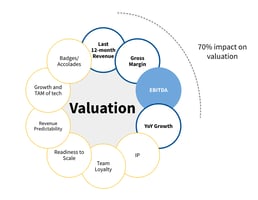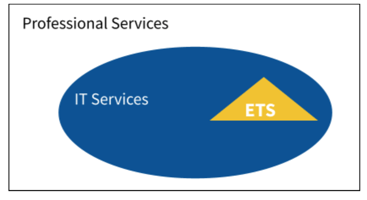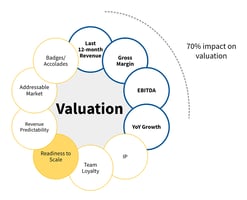Amongst the top attributes that drive ETS valuations, EBITDA is right up there with Growth rate,...
Guarding Against Down Quarters: KPIs For A Healthy Tech Services Sales Pipeline
Any technology services company is a careful balance of your capacity and your sales. Founders have to manage this balance to rapidly grow their tech services businesses. Previously, we wrote about how tech sales are different and what you need to drive the business towards:

Balance Sales And Capacity: In a fast growing business you need to find the balance between sales and capacity. Any extra money that you have, you put to increasing both of those.
Going Up Market: You start off with little reputation and start going up market as you gain case studies. Customers also sign larger deals. This will naturally increase gross margins and predictability.
Specialized Skills: The importance of balancing sales and capacity increases because to increase your margins and customer happiness you need to back with IP and training in specialized skills for your team. This means growing capacity is as important as growing sales.
Critical Metrics
To achieve these goals you need to have a complete understanding of your sales pipeline. The metrics below come together to give you an understanding of your sales pipeline health and alert you of any issues.

Backlog And Current Quarter Revenue
The first metric you need to look at is your backlog or contracted revenue. Most likely you already have an understanding of your backlog from the need to service the existing customers. You should also monitor your current quarter revenue. The backlog is used as the foundation for the rest of your planning.

Revenue & Bookings Targets
Next you create the revenue and bookings targets for the next year. Having an ambitious yet achievable target allows you to work backwards and structure your pipeline accordingly. It will be the center of the world on which you base the rest of the company.
You shift left to understand the demand generation work to hit your revenue and bookings goals. In addition since . The current quarter bookings and backlog can be used to calculate the next quarter revenue.

Factored Pipeline and Closed In Quarter to Target
To ensure that booking targets for the current quarter are met, monitor your factored pipeline and compare it with your targets. Factored pipeline refers to the sum of the value of each opportunity multiplied by its probability of closing.
This lets you know if you can realistically hit your bookings goal for the quarter. Without a Hail Mary there is little you can do if your factored pipeline and closed business is not close to target.

Unfactored Pipeline To Factored Pipeline
Everything until now has given an understanding of the reality of the business. There isn't much in your power to do if you identify an issue other than brace for impact. The first place you can start hitting is measuring the ratio of your unfactored pipeline (raw sum of all the deals in your pipeline at all stage) to factored pipeline.
Typically, the ratio of factored to unfactored pipeline is about 3x and should remain relatively stable for a given company. This ratio ensures your pipeline for the next quarter isn't depleted. If this number is low you should start hitting your Rolodex to get some new opportunities in the pipeline.

Marketing Qualified Leads (MQL) Rate
Once you have a handle on how your opportunities convert into bookings you need to generate the oportunities. You'll have to track the MQLs by each source and create initiatives into growing the number of MQLs. You will also need create initiatives to grow the number of MQLs and processes for nurturing the MQLs into opportunities.
Improvement Metrics
The above metrics shed light on critical issues. But for a growing company you have to constantly get better and improve. Constant improvements to these metrics will improve your business. A sharp decline in these metrics can also lead to critical failure for your pipeline, so in some cases these metrics may become critical metrics.
Backlog and Deal Duration Over Time
As a growing company your deal size will start increasing. But when we relate the revenue to bookings it is very easy to assume that deal size is the same. But as we mentioned earlier this assumption is most likely false. So we need to monitor changes in deal duration to ensure that short-term revenue isn't compromised by large contracts that take longer to complete. You may need to increase your bookings goal beyond your increase in revenue if you are expecting your deal duration to increase.
Deal Size
Monitor your deal size to see if it's increasing over time. This reflects you developing deeper relationships with your customers. In addition newly entered opportunities in your pipeline need estimates. A good estimate is your average first deal size. If your deal size sees a sharp decline then your unfactored pipeline can be overestimating.
Close Rate
Tracking the close rate is crucial to identify areas of improvement in the sales process and to ensure the close rate isn't dropping. An improved close rate indicates better sales processes and more refined targeting. A sharp drop in the close rate may lead to not enough of your opportunities converting. This is especially important to watch as you scale your sales processes.
Deal Close Time
An increase in deal close time has similar implications to deal close rate. Even if you eventually close the deals the lost time still has a monetary impact because it will leads to a drop in utilization. Changes in deal close time are also a natural consequence of going up market. Larger customers have longer processes for closing deals. Larger deals require higher approvals. So your deal time will naturally change as you mature.
New vs. Recurring vs. Re-occurring Revenue
Finally, track the balance of new, recurring, and re-occurring revenue. This balance is crucial to maintain a healthy mix of clients and a stable revenue stream. Increasing re-occurring and preferably recurring revenue is the key to grow a services business. It provides steadiness of revenue and decreases the reliance on new customers allowing you to increase your growth rate.
One thing we want to note is that the critical KPIs we discussed are designed for project work. Managed services, resell, and other recurring revenue is in many ways closer to SaaS. You need to separate out the revenue by business unit and use SaaS metrics.
Initially when you start your business you are trying to find service market fit. But to grow you have to operationalize your business. Getting these metrics in place will form the basis for operationalizing your business. For you to improve the metrics and improve close rates you'll need to have a differentiated positioning. Please check out our whitepaper on how to improve your positioning so your message resonates with contacts and leads to more closes.




